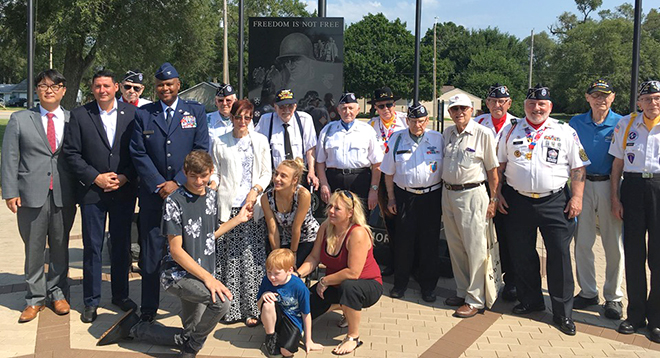Korean War Armistice recognized on 66th anniversary

courtesy photo The Journal
Rep. Cabello joined veterans and their families this weekend at the Tri-County Korean War Memorial in Loves Park to commemorate the 66th anniversary of the Korean War armistice.
By Margaret Downing
Reporter
On Saturday, July 27, Korean War Veterans Association Chapter 272 members, their families, a number of local officials, and others, attended an “anniversary” event at the Korean War Memorial, located at the Arthur Anderson Peace Park Field of Honor adjacent to the Loves Park City Hall complex.
The Memorial, dedicated on July 27, 2008, was constructed to remember and honor area men who died for our country in that war. That date, July 27, was the day the Armistice was signed in Korea to end the Conflict, which is now officially recognized as the Korean War.
Chapter members and others successfully raised funds for several years to start building the memorial in 2007 at a cost of $169,000 for materials and construction, and an additional $15,000 for an endowment fund.
The date of July 27, 2019 marked the 66th anniversary (July 27, 1953) of the signing of the Armistice and because of that the KWVA hosted an event in that honor.
A good representation of area officials were present to speak to attendees and included Consul Kim Jiman, Consulate General of the Republic of Korea; Colonel Duane Hayden, Illinois Air National Guard; State Rep. John Cabello; Senator Dave Syverson; State Rep. Joe Sosnowski; all being introduced by Veterans Memorial Hall Executive Director Scott Lewandowski. Korean War vet and KWVA member Howard Ballard, read the invocation and closing prayer and specifically noted how three cherished members had passed away within the past month.
Military data concerning Americans is currently estimated to be around 7,700 military personnel unaccounted for to this day, the majority of remains presumed to be in North Korea.
The recently officially named “Korean War” also goes by the “Korean Conflict” and the “Forgotten War.”
Following is a transcription of the words on the backside of the main stone of the Tri-County Korean War Memorial in Loves Park:
*The Korean War and Its Historical Impact:
“At the end of World War II in 1945, the Soviet Union wanted to spread the Communist Doctrine to as many countries as possible. This set the stage for the Cold War, in which every conflict became a contest between the United States and the Soviet Union. In 1945 Korea was divided at the 38th Parallel into two countries – the Democratic People’s Republic of Korea (North) and the Republic of Korea (South). The Soviets occupied the North and the Americans occupied the South. Both countries pulled out three years later.
“On June 25, 1950, with the approval of Soviet leader Joseph Stalin, North Korea launched a surprise attack, with the North supported by Soviet tanks and planes and a superior number of troops, the South Korean Army was no match. The United Nations voted to “furnish such assistance as may be necessary to repel the armed attack and restore…security in the area.” Eventually, 21 nations provided assistance, and General Douglas MacArthur was appointed the Supreme Commander of all United Nations forces in Korea by President Harry S. Truman.
“Initially the American troops suffered thousands of casualties and were forced to retreat 100 miles south of the 38th Parallel to an area called the Pusan Perimeter. The North Koreans attempted to drive the U.N. Forces into the sea, but failed and suffered many casualties. On September 15, 1950, American units staged an amphibious invasion behind the North Korean lines at the Port of Inchon, cutting off the enemy supplies. At the same time the army at Pusan broke out, and the North Korean Army was disintegrating as a fighting force. The United Nations ordered the attack be continued into North Korea.
“Eventually the Allied Forces reached the Yalu River bordering China. Moa Zedong, the Chinese leader, grew concerned. He had no intention of allowing a hostile power to border his country. Again the Soviet Union offered arms, military advisers, support troops, pilots and MIG fighter planes to the Chinese. On October 26, 1950, the Chinese, with massive attacks using waves of troops, assaulted the U.N. Forces. The attacks continued through December. Overwhelmed and outnumbered, the United Nations Forces were driven below the 38th Parallel.
“On January 25, 1951, employing air, armor, and artillery, the United Nations recaptured the South Korean capital of Seoul and pushed the Chinese and North Koreans north back across most of the 38th Parallel. On July 10, 1951, the United Nations and Communist negotiators sat down for the first time to begin truce talks. Over the next two years the war was waged for limited goals, fighting for hills and outposts. These battles were costly, with 30,000 Americans losing their lives. On July 27, 1953, an Armistice was signed, and at 10 p.m. all firing ceased. No Peace Agreement has been signed, making this the longest war in the history of the United States. South Korea was saved from Communism. “The aftermath of the war would eventually lead to the downfall of the Soviet Union.
The war lasted 37 months and two days. Americans Killed in Action totaled 36,940. A total of 103,284 Americans were wounded, and 8,177 were reported Missing in Action. The largest number of troops furnished by the United States at any given time was 302,483. A total of 1,587,000 U.S. personnel served in Korea during the war. North and South Korea are believed to have lost more than 2 million military personnel and civilians.
“FREEDOM IS NOT FREE!”



